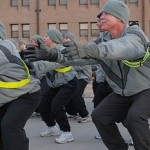Pull-ups and chin-ups are incredible exercises to do. They only require something to hang from and can build a phenomenal build. But these movements are also intimidating for many people to start. I’ve been asked before, how can I even begin to learn how to do a pull-up? Let’s walk through the basics of the movements and lay out a plan on how to do pull-ups and chin-ups.
Why Do Pull-ups and Chin-ups?
Pull-ups and chin-ups are a simple bodyweight exercise that is too often overlooked. When writing this post I found a list of 10 reasons to do chin ups. Here is summarized version of the ten reasons to do pull-ups and chin-ups.
- Closed Kinetic Chain Exercise (wikipedia) are movements where the body isn’t fixed and forces more muscles to be engaged. These movements also transfer better to function movements; livin’ life.
- Direct Strength Transference – the pull-up and chin-up fit the pattern of core lifts like bench press and overhead press.
- More Muscles than machines.
- Abs – the bodyweight chin-up led to the highest level of lower rectus abdominis activation. It surpassed every ab exercise imaginable – even ab wheel rollouts and hanging leg raises.
- Chin-ups are king for upper back development.
- Standard exercise for special forces and elite organization fitness testing
- Chin-ups build biceps
- Create the sought after gymnastics build
- Builds great grip strength
- Forces command of your own body weight – essential for most sports
Learn To Do you First Pull-Up
There are many ways to build up to your first pull-up. I’ve tried many approaches, including lat pull-downs, assisted bands, assisted pull-up machines, and more. What I’ve discovered may seem too simple.
To do pull-ups, … do pull-ups.
Okay, let me explain.
To learn to get your first pull-up start with negatives. A pull-up or chin-up negative is jumping up into the top-most position (I used my plyo box) then holding the position and slowly lowering yourself down. This movement will build the underlying strength you need to accomplish that first pull-up. Keep doing negatives, then work towards a pull-up by doing partials. A partial pull-up is exactly what the name implies by only completing part of the full range of motion. Doing partials will start to build more of the your strength to start the movement.
Keep working sets of negatives and partials. Soon you’ll be doing your first pull-up.
Google+ Pull-up Chat
Last week I tried using a Google+ huddle to talk about Pullups. While I ran into technical difficulties a few of us had a Google+ Pull-up Chat. (If you want an invite to Google+, signup for my newsletter and let me know. I’d be glad to invite you.)
During the chat we talked about uncovering the reasons behind wanting to do pullups. Some want to do more to pass a fitness test or compete in a crossfit-style competition. Others want to pack on muscle for visual impact in the back or biceps.
Depending on your own goals how you approach pull-ups or chin-ups will vary.
Strict Pull-ups are best for developing a strong, wide, and powerful back. It isolates the lat muscles. Work your way up to 8-10 reps, then start adding additional weight. If you want to build bulk, keep the reps low and grow.
Kipping Pull-ups are a source of contention. They are a form of pull-up that uses your hips to drive your body up and over the bar. The movement doesn’t isolate the back, but will work more of your hips, core, and grip. This style pull-up is good if you are looking for maximum calorie burn from the bodyweight movement.
Pull-ups for lats, Chin-ups for biceps by switching the grip from palms away for pull-ups to palms towards you for chin-ups dramatically changes which muscles are used. Choose your grip based on which muscles you want to attack.
Extreme Pull-up and Chin-ups
I enjoy searching across youTube to find extreme examples of fitness. Some are inspiring, others funny. When it comes to pull-ups I often end up in New York. The Bronx Freestyle Calisthenics Tournament is one event that keeps popping up.
These guys are proof of what can be accomplished with minimal equipment.
Who knows. Start now and you could join these guys working on the bar. Start with negatives, move to partials. Those simple steps are how to do pull-ups when you can’t even do one.





Want to discuss? Join the conversation CubeDwellerFitness's Facebook Page.